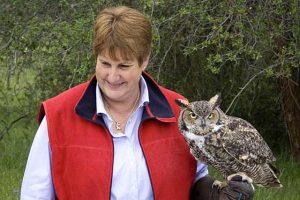Contributed by Len McKenzie —
OAKHURST — Few, if any, birds spark the human imagination more than birds of prey. Foothill area residents will have an opportunity to see some of these charismatic birds at close range, and to learn about their importance as predators atop the food chain, at Yosemite Area Audubon’s monthly program on Thursday, Nov. 10.
Master falconer Cat Krosschell, a naturalist, educator and experienced wildlife rehabilitator, will bring three live raptors and describe their adaptations, behaviors and flight characteristics in her presentation, “Birds of Prey.” Beginning at 7 p.m., the program will be presented at the Oakhurst Methodist Church on Road 426.
Krosschell’s special guests will include a peregrine falcon, a great horned owl and a red-tailed hawk, all of them significant indicators of ecosystem health. Admired for their grace, strength, speed, independence and hunting prowess, raptors, as they’re called, have remarkable adaptations and skills for capturing and eating other animals.
The peregrine falcon’s particularly striking combination of raptor traits made it a prized captive for falconry, the so-called “sport of kings,” beginning centuries ago. Diving headlong (called “stooping”) at speeds of up to 200 miles per hour on another bird in flight, it kills its victim with the force of its impact and snatches the hapless quarry in midair with its talons. Widespread use of DDT threatened the peregrine with extinction until the United States banned the pesticide in 1972, enabling its population to recover.
The great horned owl (the locally common “hoot owl” widespread across North America), like most owl species a nocturnal hunter with keen night vision and acute hearing, is a fierce, stealthy predator of mid-sized mammals, including skunks. This large owl is powerful enough to kill animals up to three times its size and can swallow rodents and small rabbits whole. Named for its cat ear-shaped feather tufts that resemble horns, it also attacks and feeds on many types of birds, including other owls, reptiles, amphibians, and even fish. Its principal natural enemy is other great horned owls!
Like the great horned owl, the red-tailed hawk is almost ubiquitous in North America. Probably the most common hawk throughout its range, and a frequently sighted resident of the Sierra foothills, these buteos (large hawks with broad wings and tails) prefer open country. They hunt from perches on power poles, fence posts, scattered trees and large rocks and well as from the open sky. Who isn’t fascinated watching a red-tailed hawk soaring aloft on thermal updrafts, scanning the ground with its sharp eyesight for small mammals and perhaps hovering briefly before plunging earthward to pounce on its unwary prey?
Both great horned owls and red-tailed hawks begin nesting in January, and local birders have recently observed courtship behavior, including nighttime hooting between male and female owls, making Krosschell’s presentation particularly timely.
“This program offers us a rare and wonderful learning opportunity and is especially appealing to children,” YAAS president Lowell Young noted. “We encourage parents to bring the kids. Their excitement and sense of wonder in seeing these birds up close are contagious!”
Krosschell’s’s presentation is open and free to the public, although donations to defray program costs and to support Audubon’s local activities are welcome.
Yosemite Area Audubon is a local chapter of the National Audubon Society and Audubon California, the state affiliate. The Audubon mission is to conserve and restore natural ecosystems, focusing on birds, other wildlife and their habitats for the benefit of humanity and the earth’s biological diversity.




